Ulster AGS Show, 2013
It is well known that the two Irish shows are, to an extent, interdependent, Ulster exhibitors travelling to Dublin and exhibitors from that county reciprocating, with an occasional grower from across the water also putting in an appearance. This all changed at the 74th Ulster Show in Greenmount this year, however, with a veritable invasion of entries from English and Welsh exhibitors, resulting in what was probably the largest AGS show ever staged in Ulster. More than 100 plants arrived on the ferry in Belfast port, causing some space problems for Pat Crossley and her team, given that entries from local exhibitors were also up. When all the plants had been marshalled and staged, they presented a dazzling display.
One significant effect of this development was that the number of entries in almost all classes in the Open Section increased significantly, as also did the overall standard. It is inevitable that the arrival of skilled exhibitors such as Don Peace at any show will lift the standard, and indeed he was awarded the Cooke Cup for most first prize points in the Open Section − the first time that this trophy has left Irish shores. Both Irish groups hope that what happened in Greenmount this year is the start of a trend, and that exhibitors from Great Britain will consider coming to Dublin and Ulster in the years ahead. They will be welcomed with open arms.
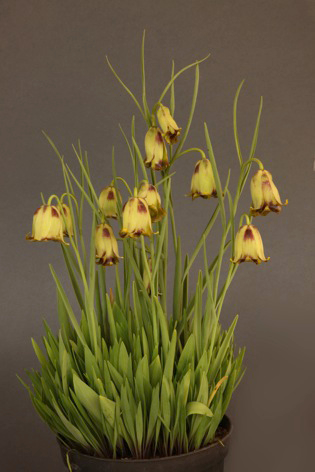
The Artistic Section was again well supported by both domestic and overseas exhibitors, but most first prize points, for the second year running, went to local stalwarts Liam & Joan McCaughey.
And so to the show benches. The Novice and Intermediate Sections were unaffected by the visitors. Sam McDowell of Limavady received most first prize points in the Novice Section, and won the trophy for the best pan of Ericaceae. Sam’s wife, Kay, gained most first prize points in the Intermediate Section, as she did last year. Mac Dunlop, who exhibited for the first time in 2012, staged the best plant in flower in the Novice Section with a nice potful of Fritillaria acmopetala.
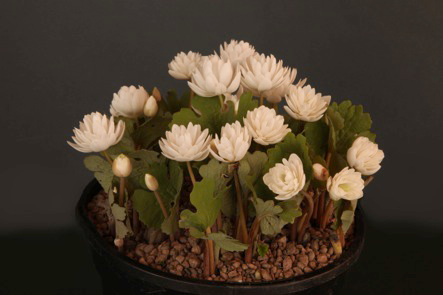
Pat Kennedy of Dublin won an AGS Spoon for her well-staged six pans in the Intermediate Section. One of her plants, Sanguinaria canadensis f. multiplex ‘Plena’ , was in exemplary condition. She has a big patch of this in her garden and lifted a portion for the show just as it started into growth. It takes luck as well as skill to have a perfect exhibit of this very ephemeral plant on the appointed day.
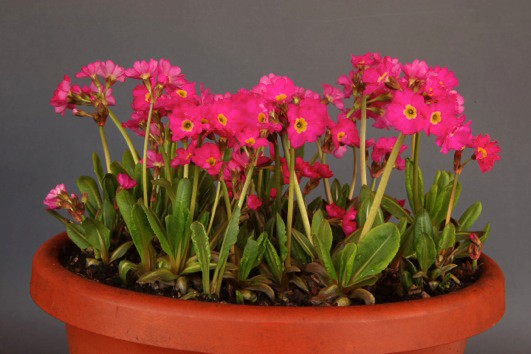
The AGS Medal for the large six-pan class in the Open Section went to Harold McBride’s beautifully balanced entry. This included a notable pan of the Himalayan meadow primrose, Primula rosea. The plants had been raised from seed obtained from Vojtĕch Holubec, and had been potted into a moisture-retentive compost incorporating added moisture crystals, then treated with Provado (this species is very subject to attack by vine weevil). Wintered outdoors, the pot was placed in a plunge frame three weeks prior to the show (in order to protect the emerging flowers from weather damage), kept well watered and given a liquid feed. The colour of this easy-going plant can be various shades of pink, and rarely white, but the plant exhibited was a vibrant rose-red that glowed on the bench.
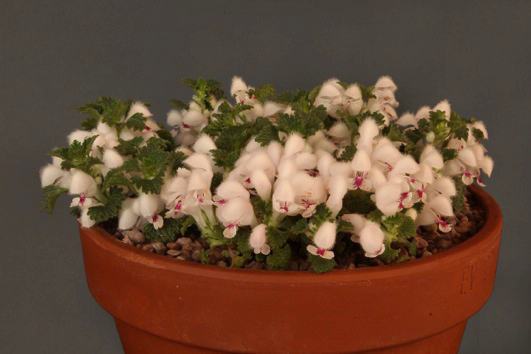
Keith & Rachel Lever showed a well-flowered pan of the very attractive Lamium armenum from Turkey. Robert Rolfe described this plant in AGS Bulletin vol. 62 (4), p. 384. The plant shown was raised from cuttings provided by Tommy Anderson and is grown in the alpine house in a free-draining, loam-based compost that is kept moist. It is a short-lived species, tending to flower itself to death, and is difficult to propagate. Cuttings must be taken from very young material, and seed should be sown fresh.
Tim Lever’s Leontopodium pusillum from China, India and Pakistan attracted a lot of interest and was given a Certificate of Merit. He says that it looks completely dead in winter, and that it is a relief to see the new green shoots in February. It is grown in Aberconwy’s standard compost, as is his floriferous Benthamiella patagonica, which thrives on relative neglect, disliking any disturbance. It too received a Certificate of Merit.
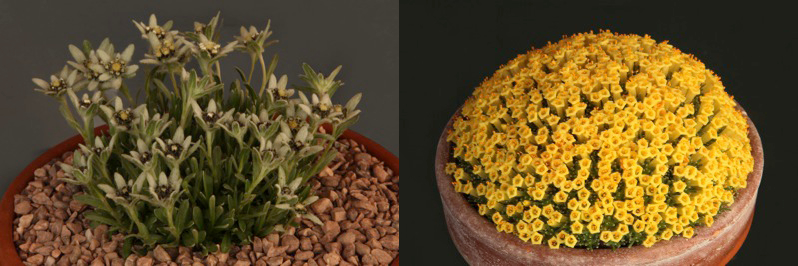
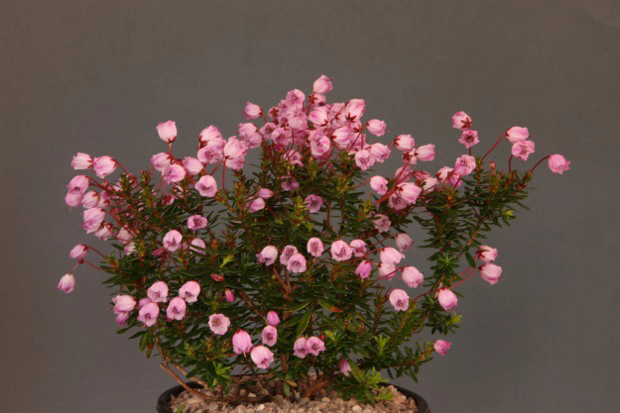
It was a good day for the Lever family as Tim’s exhibit of x Phylliopsis ‘Crinoline’, a beautiful Barry Starling cross, was given the Carol McCutcheon Award. A Certificate of Merit also went to Hugh McAlister of Castlewellan for his outstanding exhibit of Sebaea thomasii. Hugh’s wasn’t the biggest example of this plant at the Show but it was the most compact. He bought it from Aberconwy Nursery in 2009 and it now occupies a 19cm pan, this year sporting at least 120 flowers. It is grown in a mixture of equal parts John Innes no. 3, Cambark fine and coarse river sand, and kept in a sheltered frame plunged in sand where it receives good light. Only in very severe weather is it moved into the alpine house.
Good light is the key to keeping this plant compact, as even in a well-lit alpine house it tends to etiolate slightly. The plant is ‘turned’ periodically to ensure good shape and gets a light clipping over after flowering. It is much hardier than generally thought: in November 2010 I put a small specimen in a crevice where, despite several spells of very severe weather since planting, it is in flower as I write. Regrettably, due to an oversight on the part of your reporter, Hugh’s plant was not photographed.
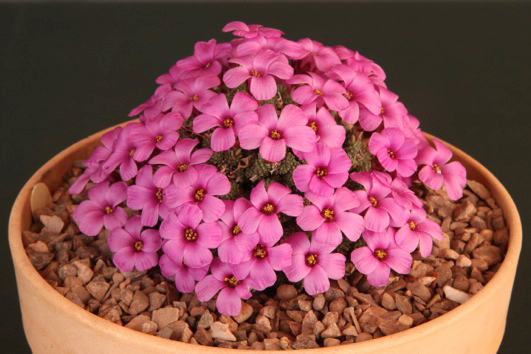
I was impressed by Ian Leslie’s Saxifraga columnaris with its rich purple, large, silky flowers. It is much slower in growth, and more difficult than S. dinnikii, which appears more often on the show bench. Both grow in the northern Caucasus at 2,000 to 3,000m and were introduced to cultivation in 1996. Hybrids between the two (S. x dinninaris) sometimes do duty for both species, and are fine plants in their own right.
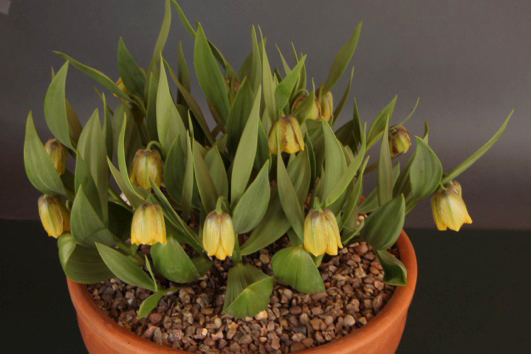
Don Peace showed a number of first-rate fritillaries, including three in the educational class. I thought that his F. crassifolia subsp. crassifolia from Turkey was particularly well shown. He finds that species native to Europe and Asia thrive under his cultivation regime, but that American species emphatically do not. He uses a surprisingly rich compost of two parts John Innes no. 3 to one part sharp grit, repotting frequently, usually in August. No supplementary feeding is given. The plants are in clay pots, plunged in sand that is kept moist at all times, in a covered, well-ventilated frame, and are watered liberally while in active growth.
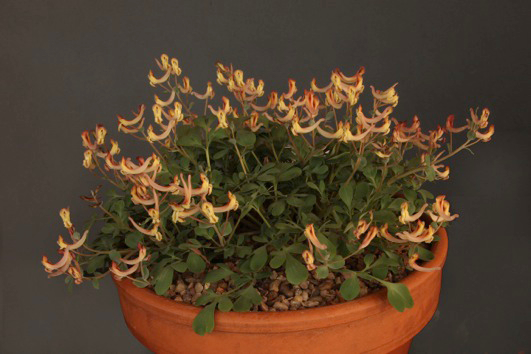
Don’s Corydalis griffithii x macrocentra, obtained from Jânis Rukšâns a few years ago, was part of his large three-pan entry and was in peak condition. According to Jânis this hybrid was raised in Gothenburg Botanical Garden and can be increased only by breaking the tuber. With this and all his other Section Leonticoides Corydalis, as soon as the foliage dies down Don removes the (clay) pot from the plunge, stacks it inside an identically-sized pot, and then returns them to the plunge. This keeps the plants away from the moist plunge but provides a buffer against temperature swings.
They are kept dry until early October when they are repotted and returned to the plunge (without the outer pot). He uses the same mix as for his frits (two parts John Innes no. 3 and one part grit), positioning an inverted plastic pot − with its base removed − over the tuber and filling this with grit, before adding the compost. The plastic collar is an attempt to stop the new growth running straight to the edge of the pot. But evidently this is only ever a partial success, since the new growth just waits till it has cleared the barrier and then runs outwards as usual.
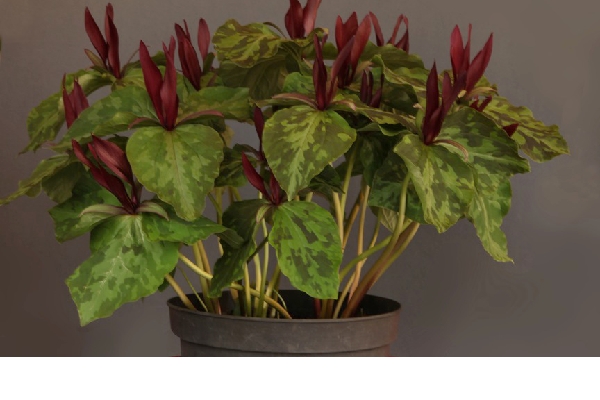
The Farrer Medal went to a pristine clump of Trillium chloropetalum shown by Gordon Toner of Limavady. Gordon grows numerous trilliums in his garden and last year noted this clump as a potential show candidate. He lifted it in August, potting it up in a mixture of good soil and leaf-mould with some blood, fish and bone added. The pot was then plunged in the garden and remained outside until February, when it was brought into a cold glasshouse to protect the emerging foliage and flowers from weather and pest damage. With 15 flowers and uniform foliage, this fine plant was thoroughly deserving of the premier award.
A downside of the influx of plants from across the water was the number of local exhibits (many of them excellent plants) that ended the day with no sticker on their show cards. A small price to pay for an exceptional show that was a fitting prelude to the 75th Anniversary event next year when, it is very much hoped, the visitors will return.
Author: Billy Moore
Photographer: Heather Smith
